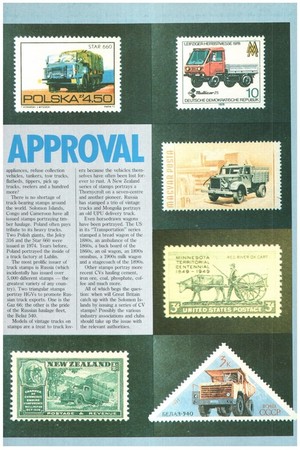Pc ch. APPROVAL
Page 38

Page 39

If you've noticed an error in this article please click here to report it so we can fix it.
• Trucks and their drivers receive little recognition for their crucial work in distributing products and foods, but a steady tribute to trucks and drivers is released by many nations on the best billboard of all — the postage stamp.
Britain, however, has never printed a single stamp acknowledging the debt owed to these vehicles. British stamps have featured seashells, yellow wagtails, Peter Rabbit, sheep, dogs, dinghies, horse chestnuts, rocking horses — even ox-eye daisies — but no trucks. We have an abundance of planes and trains but are trucks any less important?
Possibly it's because nobody ever asked for a truck stamp. Are cricket players better organised than the hauliers? Unlikely, but possible. In any case, it seems a good bet that there are more truck drivers than rocking-horse riders. Possibly the rockers care more about recognition, but how did the yellow wagtails get ahead of the truck drivers?
Ever since Britain issued the first stamp in 1840, postmasters general have commemorated the individuals, historic events and technologies which have shaped the nation's destiny. Those accorded such a stamp of approval have a permanent niche in the annals of human history.
Should future archaeologists ever dig up a 20th century stamp collection, they would be able to decipher a lot about the vital role of trucks in our society.
How could any country prosper without cement trucks, fire appliances, refuse collection vehicles, tankers, tow trucks, flatbeds, tippers, pick up trucks, reefers and a hundred more?
There is no shortage of truck-bearing stamps around the world. Solomon Islands, Congo and Cameroon have all issued stamps portraying timber haulage. Poland often pays tribute to its heavy trucks. Two Polish giants, the jelcy 316 and the Star 660 were issued in 1974. Years before, Poland portrayed the inside of a truck factory at Lublin.
The most prolific issuer of truck stamps is Russia (which incidentally has issued over 5,000 different stamps — the greatest variety of any country). Two triangular stamps portray HGVs to promote Russian truck exports. One is the Gaz 66; the other is the pride of the Russian haulage fleet, the Belaz 540.
• Models of vintage trucks on stamps are a treat to truck loy ers because the vehicles themselves have often been lost forever to rust. A New Zealand series of stamps portrays a Thornyeroft on a seven-centre and another pioneer. Russia has stamped a trio of vintage trucks and Mongolia portrays an old UPU delivery truck.
Even horsedrawn wagons have been portrayed. The US in its "Transportation" series stamped a bread wagon of the 1880s, an ambulance of the 1860s, a buck board of the 1860s, an oil wagon, an 1890s omnibus, a 1900s milk wagon and a stagecoach of the 1890s.
Other stamps portray more recent CVs hauling cement, iron ore, coal, phosphate, coffee and much more.
All of which 'begs the question: when will Great Britain catch up with the Solomon Islands by issuing a series of CV stamps? Possibly the various industry associations and clubs should take up the issue with the relevant authorities.
















































































